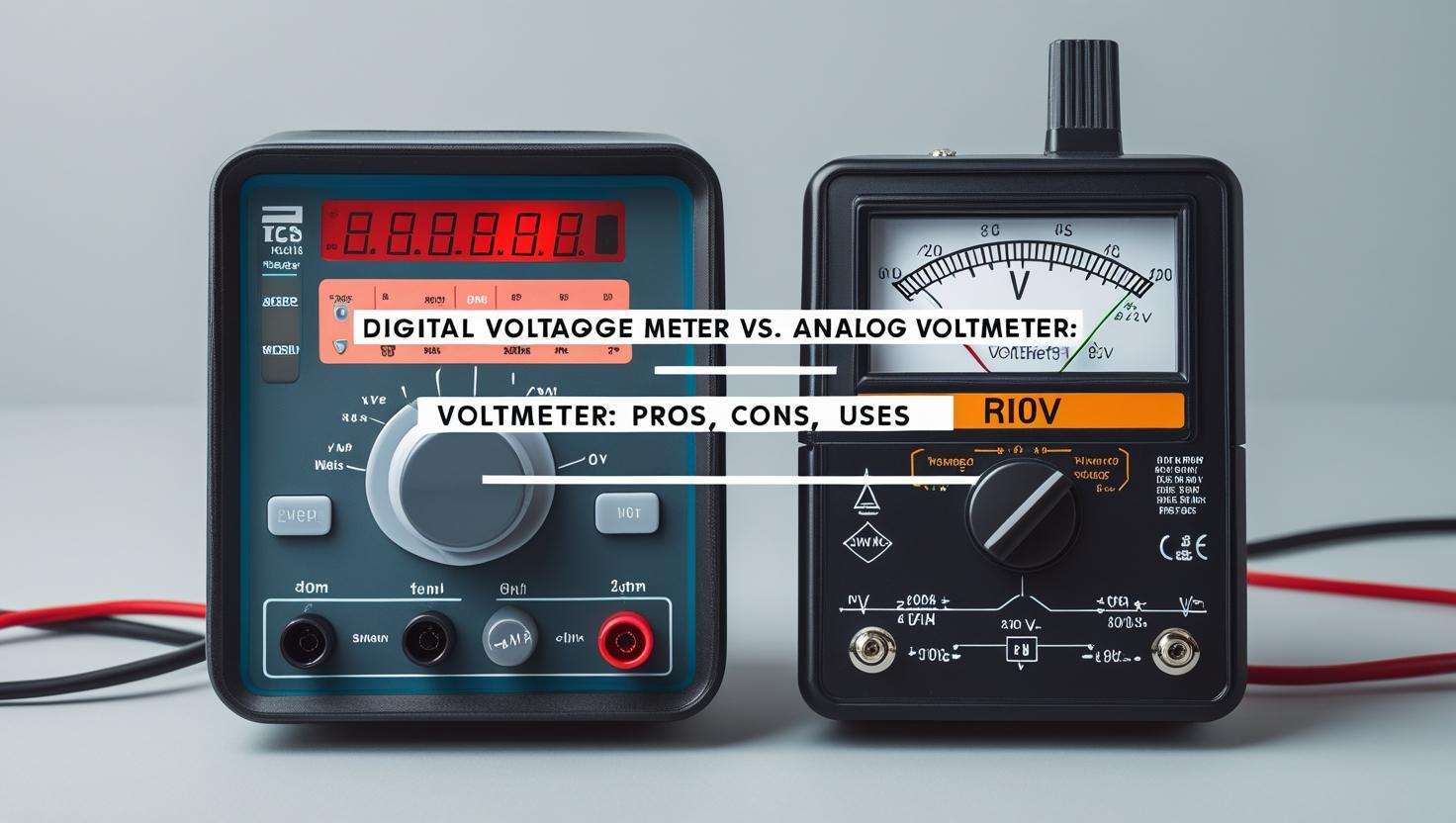 teddy@teddyele.com
teddy@teddyele.com +86 13968749891
+86 13968749891


 +86 13968749891
+86 13968749891

Jul 4,2025
A voltage meter, aka a voltmeter, is a device that calculates the voltage or electrical difference between two points of an electronic or electrical circuit. Generally, the voltage meter is used for alternating current (AC) circuits or Direct Current (DC) circuits. Instead of this, Radio Frequency (RF) voltage can also be calculated by specialized voltage meters.
Voltmeters, or voltage meters, are pivotal for ensuring the safety and perfect functioning of electrical systems. They are used to calculate voltage, which is the electrical potential difference between two points in a circuit. This calculation assists in identifying potential problems. Those issues can be overvoltage or undervoltage. These are the problems that can harm equipment or cause safety risks/dangers.
Making a choice between digital or analog voltage meters is very important as they provide numerous strengths and weaknesses, affecting measurement precision, convenience of use, and cost. Digital voltmeters usually offer higher precision and accuracy. Especially for sensitive calculations, analog voltmeters can be more intuitive in visualizing fluctuations and are frequently more budget-friendly.
By the end of this blog, you will get to know the difference between a digital voltmeter and an analog voltmeter. Also the pros, cons, and uses of them. So, let’s begin.
A digital voltmeter is an electronic device that calculates voltage by turning an analog signal into digital data and showing it in figures.
Typical applications of Digital Voltage Meters (industrial panels, automation systems, Solar and Wind setups)
Digital voltmeters are widely used in industrial control panels to keep track of the voltage levels of machinery and electrical systems on a daily basis. In these sectors, accurate calculation is pivotal to ensure the equipment operates within specified voltage limits. Cases like over-voltage or under-voltage can lead to the wrong functioning of equipment, reduced efficiency, or even cause harm.
By giving precise, real-time voltage readings, digital voltage meters assist operators in finding anomalies in advance and taking corrective action. This enhances both the safety and trustworthiness of industrial methods, and you can try industrial-grade mini circuit breakers while working with high-voltage equipment.
This era’s automation systems, digital voltage meters, are pivotal for examining and operating the voltage of numerous parts, such as Programmable logic controllers (PLCs), sensors, actuators, and motors. These systems require precise voltage to function correctly, especially in factories where speed and consistency mean a lot.
Digital voltmeters display the voltage in real time, which assists the system in making changes or providing warnings in case the voltage is wrong. These assists keep everything running flawlessly and allow issues to be solved in advance before any equipment stops working.
Digital voltage meters are very helpful in solar and wind power. They are used to examine the voltage passing through the following panels:
• Solar panels
• Wind turbines
• Inverters
By displaying the right voltage, they assist in determining whether the batteries are charged and safe from being overcharged or used too much. This also assists the system completely by keeping the voltage stable, which is pivotal for turning and sharing clean energy perfectly. If the voltage is not monitored properly, the system might not function properly or could harm vital parts.
New to electrical measurement? Start with the comparison of Voltmeter vs Multimeter to understand the difference and what to use and when.
An analog voltmeter is an electrical instrument used to calculate voltage in a circuit, showing the results on a scale with a pointer or needle. It operates on the principle of a moving coil mechanism, generally using a D’Arsonval galvanometer.
Traditional Uses of Analog Voltmeters in Labs, Classrooms, or Legacy Equipment
Educational institutes use analog voltmeters in labs and classrooms for study purposes and to teach students practically about the basics of electricity and voltage measurement. Their simple structure, consisting of a moving needle and scale, assists learners in visually grasping how voltage changes. So that students get to learn how the needle functions, which helps build a robust foundation in electrical concepts. Analog meters are mostly used in basic experiments as they don’t need a complex digital explanation.
Numerous traditional machines and electrical systems still use analog voltmeters built into their control panels. They can be seen in factories, power plants, and testing places. These systems were invented a long time ago and still work ace. That is why they don’t always require digital upgrades to function nicely. Analog voltmeters in these setups provide precise and dependable results without requiring any software or programming.
|
Feature |
Digital Voltage Meter |
Analog Voltmeter |
|
Display |
Numeric (LED/LCD) |
Needle/Dial |
|
Accuracy |
High |
Moderate |
|
Response Time |
Instant |
Slight delay |
|
Durability |
Sensitive to overload |
Robust in rough conditions |
|
Cost |
Slightly higher |
Usually, cheaper |
|
Ideal for |
Precise industrial use |
Visual trends or legacy systems |
Digital voltmeters give precise voltage results, frequently more precise than analog meters. This makes them perfect for detailed measurements in advanced systems.
They show figures on a digital screen, which is easy to read with the naked eye. It also minimizes the chances of human mistakes when noting results.
Numerous digital voltmeters offer useful attributes such as True RMS (Root Mean Square) measurement, auto-ranging, data hold, and backlit screens. Plus, even connectivity to computers for data recording.
Digital voltmeters are mostly costly if compared to basic analog models, especially those that have modern attributes and higher accuracy.
They can be affected by vigorous electromagnetic fields, which may lead to wrong readings or malfunctions in particular environments.
The moving needle makes it easier to note fast voltage changes or fluctuations at first sight.
Many analog voltmeters function without batteries. It makes them trustworthy in scenarios where power is limited.
If we compare them to digital meters, analog voltmeters are not sensitive. Or you can say that they can function fine in dust and harsh conditions.
It's very hard to receive an accurate number from the scale. This can give you wrong results.
Analog meters cannot be used in modern devices and equipment because they are not compatible with them.
Digital voltage meters are normally used in industrial control panels to monitor the voltage of machines and electrical systems. They ensure the equipment is functioning within safe voltage levels. They also warn users if something is wrong, assisting to prevent harm or stoppage.
In solar and wind setups, digital voltmeters play a pivotal part. They examine the voltage output from panels, turbines, and inverters. Besides, they assist in maintaining efficient power production and make sure batteries and other components are perfectly safeguarded from overcharging or deep discharge.
Digital voltage meters are used in electric vehicle stations to keep track of voltage levels while the car is in the charging mode. This ensures the charging is happening in a safe manner and safeguards the battery. It also prevents the electrical system from getting overloaded.
In smart homes, digital voltmeters are built into smart meters and automation systems to monitor voltage usage and catch malfunctions. This information assists homeowners in managing energy use more efficiently and prevents them from any electrical problems.
Digital voltmeters are pivotal tools in electronics labs and manufacturing for experimenting with printed circuit boards (PCBs) and other electronic parts. They assist engineers in calculating voltage across several components of a circuit to ensure the right working during development and repair.
Analog voltmeters are mostly used in educational institutions for study purposes. It is to teach them how basic electricity and circuits work.
In power generation setups, analog voltmeters are used to keep track of voltage levels in generators and transformers. They give an instant visual examination to make sure everything is working within safe limits.
Several traditional machines and systems still have analog voltmeters built into their control panels.
Analog voltmeters are strong and can handle rough use, making them perfect for outdoor or fieldwork where the weather is likely to be dusty, wet, or bad.
In systems where the voltage keeps changing, such as in a few power loads, analog meters assist in displaying these functions flawlessly. The needle movement enables a person to note instant changes better than a digital display.
To start, power on the digital voltmeter with the help of the power button. Or, you can also do it by rotating the function dial to a voltage setting. See if the display lights up and the device is functioning perfectly before it starts measuring.
Select the correct type of voltage to measure. If you are measuring voltage from a battery or other direct current source, choose the letter V, which has a straight line (DC). For household outlets or alternating current sources, select the letter V having a wavy line (AC). If your meter features an auto-ranging feature, it will automatically set to the right range. Or else, manually choose a voltage range a little higher than your expectation to measure.
Put the test leads into the right ports on the meter. Make sure that the black lead is put into the port which reads “COM”, which is a common ground. The red lead has to go into the port, which reads “V” for measuring voltage. Ensure that all leads are inserted in the right ports to avoid any wrong readings or safety issues.
Gently place the leads on the circuit you wish to test. Touch the black lead to the negative or downside, and the red lead to the positive side or the test point. But be very careful while doing all this that you don’t touch the metal components of the leads, especially when the equipment voltage is high.
When the leads are connected, look at the digital screen to see the voltage readings. The meter will display the voltage existing between the two points you are experimenting on. This reading will generally show within a second or two and is displayed in volts, also denoted by “V”.
When you are done measuring, take out the test leads from the circuit. Then, turn off the meter. After that, keep it in a dry and safe location.
Read about the digital multimeter accuracy to understand how and when to use and understand its readings correctly.
Always give significance to safety when doing such dangerous work. Do not touch exposed wires, keep your hands dry, and wear safety gloves if you feel the need to. Begin with the highest voltage range if you don’t have any idea about the voltage level. Also, do not use broken test leads or a bad meter.
On an analog voltage meter, a needle moves to indicate the voltage levels on a scale. As you connect the meter to a circuit, the needle changes its position and stands parallel to the voltage value. The more voltage there is, the faster the needle changes its place and goes in the right direction. See the movement of the needle; this will help you evaluate whether the voltage is steady or changing.
Analog voltmeters generally contain more than one scale marked on the screen. Remember to read the scale that matches the range setting you have chosen on the meter. For instance, if the dial is fixed on 0-10, use the scale that goes from 0 to 10. Take a look at the number and the location of the needle to get the voltage value.
Always look at the needle right from the front if you want to get an accurate reading. Why? Because if you look at it from any other angle, it will show you a wrong reading. This is because angles matter a lot. This misunderstanding is known as a “Parallax Error”. However, several meters contain a thin mirror strip right behind the needle to show you the correct display in the form of a reflection.
One should always wear PPE while testing exposed wires. Why? Without them, you can get an electrical shock or have a serious injury. Thus, these dangers can be life-threatening, so always be careful while handling these things.
Selecting the wrong voltage range on the meter can cause wrong readings. This can also harm your device. If the chosen range is too low for the voltage being measured, there is a chance it could overload the meter. Therefore, it's safer to begin with the highest range and then go downwards if required.
Not being able to connect the ground lead properly (generally the black one) is a mistake almost everyone makes. Without a good ground connection that isn’t secure, the voltage reading may be inaccurate or unstable. Always make sure the black lead is put in the port that reads “COM”. Also, ensure that it is connected to the right ground point in the circuit.
So, this was the ultimate guide on digital voltage meter vs. analog voltmeter, its benefits, disadvantages, and uses. In comparison, the major difference between a digital voltage meter and an analog voltage meter is simple. A digital voltmeter shows the reading through a display, while an analog voltmeter shows the reading with a needle.
We have also discussed safety tips while using both of these voltmeters, which you should follow for safety. Also, when you plan to buy any of these voltage meters, give priority to the quality and not to a low price. However, if you are now looking forward to buying, then visit our digital voltage meter collection to buy from a variety of products.